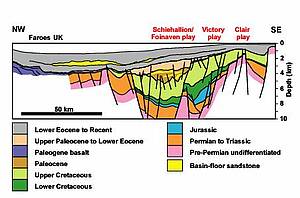Studies of the influence of changes in relative sea level and rate of sediment supply, which make the basis for sequence stratigraphy, have so far been most successfully applied to transitional and shallow-marine environments. In such environments, there are also potential links between sequence stratigraphy and the mineralogical and geochemical modifications, which hence allow a considerably improve ability to predict the reservoir quality of these sediment packages. Conversely, both sequence stratigraphy and its relationship to the mineralogical, geochemical composition and reservoir quality of deep-sea sediments are still poorly constrained in the literature. The fundamental hypothesis that we thus seek to test is that changes in the relative sea level are probably accompanied by predictable changes in the primary sand composition and texture as well as the diagenetic modifications of deep-marine clastic sequences in passive continental margins. The present proposal brings together a large spectrum of approaches to develop our understanding of the geometry and the prediction of reservoir quality in this tectonic setting. A detailed assessment of the mineral content and texture of these reservoirs is, for the first time, tentatively integrated with facies analysis in a sequence stratigraphy context, exploring the interest of bulk rock geochemistry in scaling upwards the mineralogical information. The expected achievement is a conceptual model predicting primary sand composition and, when combined with modeling of the thermal history and the fluid-induced changes in mineralogy and porosity-permeability, an integrated tool for the evaluation of reservoir quality in deep-marine clastic deposits. The sequences selected to test our basic hypothesis and the complementarities of the proposed approaches are taken from offshore New Jersey as well as from the 4 Faeroe/Shetland and the Vøring Basin, at the British and the Mid-Norwegian continental shelves, respectively.
Other information
 |
Diagenesis and reservoir quality evolution in deep-water, marine Sandstones
S. Morad, A. Amorosi, D. Garcia, R. Marfil, J. P. Nystuen, H. Mansurbeg
In the past decade, deep-water marine sandstones have become increasingly the focus of hydrocarbon reservoir targets. Thus, while the exploration and production activities decline in the North Sea, the Atlantic margin, west of the British Isles and Norway has become the site of intense exploration activity. The targets for this study are Faeroe/Shetland and the Vøring Basin, at the British and the Mid-Norwegian continental shelves, respectively. The diagenetic evolution and its impact on reservoir quality evolution of sandstones is one of the critical aspects in understanding the basic elements of the play in these settings.
Unraveling the diagenetic evolution of sandstone sequences using integrated petrologic, geochemical, sedimentological and sequence stratigraphic approach provides a firm basis for better understanding and prediction of the origin and distribution of temporal and spatial reservoir properties. The diagenetic evolution pathways of sandstones are governed by several interrelated parameters, including composition of framework grains, organic matter content, chemistry of depositional waters(marine, meteoric or brackish) as well as the extent and type of geochemical modifications induced to them due to sediment-water interactions, tectonic setting , and burial-thermal history of the basin. Furthermore, changes in the relative sea level, which occurs due to eustatic sea-level changes and/or the tectonic uplift/subsidence control important aspects of sediment diagenesis such as: (1) pore water composition, (2) detrital composition and sorting, and (3) sedimentation rates, which control the duration of sediment residence at near sea floor conditions.
Fig.2. SEM images displaying grain-replacing, disordered kaolinite (A) that has been transformed partly into well-ordered kaolinite and dickite (B). (C) and (D) Optical micrographs showing kaolinitization of mica and feldspar.
Publications:
Caja, M.A., Marfil, R., Garcia, D., Remacha, E., Gual, G. (2005). Dolomitisation processes affecting the yellow marker beds in the turbidite systems of the Hecho Group, South Central Pyrenean basin, Spain. General Assembly of the European Geosciences Union (EGU), Vienna, Austria. Geophysical Research Abstracts, Vol. 7, 09493.
Mansuberg, H. Morad, S. Amorosi, A. Garcia, D. Marfil, R and Nystuen, J.P. (2005). The impact of meteoric -water flux on diagenetic alterations in Paleocene deep-water, marine sandstones, The Shetland-faroes basin, The Brithish continental shelf. General Assembly of the European Geosciences Union (EGU), Vienna, Austria. Geophysical Research Abstracts, Vol. 7.
Marfil, R., Garcia, G., Caja, M.A:, Remacha, E., Morad, S., (2006). Condensation levels affected by dolomitisation and their reliability as time-markers within sequence stratigraphy frameworks of turbidite systems. Examples of the Eocene Hecho Group (South-central Pyrenees, Spain). In Linking diagenesis to sequence stratigraphy of sedimentary rocks Spc. Publs int. Ass: Sediment. Submitted
Caja, M.A., Mansuberg, H., Morad, S., Marfil, R., Garcia, D.,Remacha, E., Amorosi, A., The diagenetic evolution and porosity destruction of hybride turbidites of the Hecho Group (South-central Pyrenees, Spain), in preparation.
Marfil, R., Garcia, D., Caja, M.A., Morad, S., Mansuberg, H., Remacha, E., Amorosi, A. Integrated petrological and geochemical analyses of Eocene turbidites of the Hecho Group (South-central Pyrenees, Spain) in relation to provenance changes. In preparation.
Mansurbeg, H., Morad, S. and Plink-Björklund, P., 2005. The impact of meteoric water on the diagenetic alterations in deep-water, marine siliciclastic turbidites. Journal of Geochemical Exploration, (Accepted).

Project Leader:
- SadoonMoradE-Mail
- Uppsala UniversityDepartment of Earth SciencesUppsalaSweden
Principal Investigators:
- AlessandroAmorosiE-Mail
- University of BolognaDepartment of Earth SciencesBolognaItaly
- DanielGarciaE-Mail
- Ecole Nationale Superieure des Mines de St. EtienneCentre SPIN -department GENERICSaint-EtienneFrance
- RafaelaMarfil PérezE-Mail
- Universidad Complutense de MadridFacultad de Ciencias GeológicasDpto. Petrologia y GeoquimicaMadridSpain
- PetterNystuenE-Mail
- University of OsloDepartment of GeologyOsloNorway
- Rudy Allin JozefSwennenE-Mail
- Catholic University of LeuvenFaculty of Earth and Environmental SciencesAfdeling Fysico Chemische GeologieHeverleeBelgium

